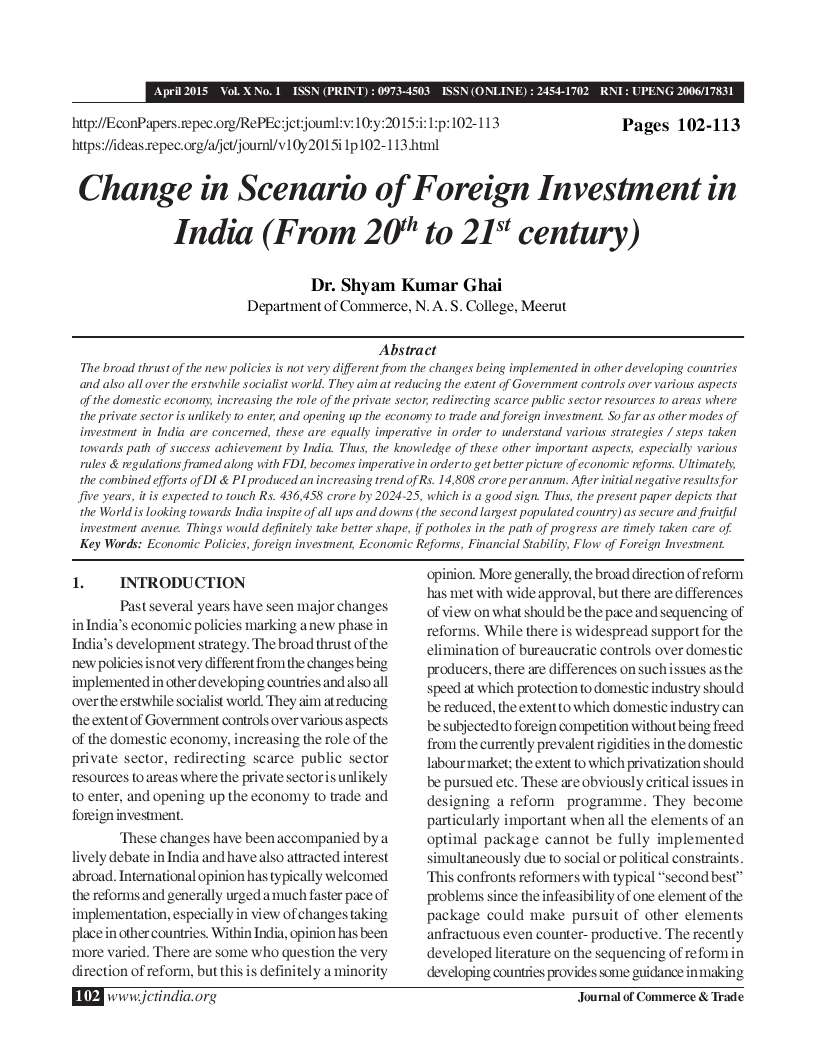Change in Scenario of Foreign Investment in India (From 20th to 21st Century)
DOI:
https://doi.org/10.26703/jct.v10i1.203Keywords:
Economic Policies, Foreign Investment, Economic Reforms, Financial Stability, Flow of Foreign InvestmentAbstract
The broad thrust of the new policies is not very different from the changes being implemented in other developing countries and also all over the erstwhile socialist world. They aim at reducing the extent of Government controls over various aspects of the domestic economy, increasing the role of the private sector, redirecting scarce public sector resources to areas where the private sector is unlikely to enter, and opening up the economy to trade and foreign investment. So far as other modes of investment in India are concerned, these are equally imperative in order to understand various strategies / steps taken towards path of success achievement by India. Thus, the knowledge of these other important aspects, especially various rules & regulations framed along with FDI, becomes imperative in order to get better picture of economic reforms. Ultimately, the combined efforts of DI & PI produced an increasing trend of Rs. 14,808 crore per annum. After initial negative results for five years, it is expected to touch Rs. 436,458 crore by 2024-25, which is a good sign. Thus, the present paper depicts that the World is looking towards India inspite of all ups and downs (the second largest populated country) as secure and fruitful investment avenue. Things would definitely take better shape, if potholes in the path of progress are timely taken care of.
Downloads
References
Alhijazi, Yahya Z.D (1999): “Developing Countries and Foreign Direct Investment”, digitool.library.mcgill.ca.8881/dtl_publish/7/21670.htm.
Balasubramanyam V.N, Sapsford David (2007): “Does India need a lot more FDI”, Economic and Political Weekly, pp.1549-1555.
Basu P., Nayak N.C, Archana (2007): “Foreign Direct Investment in India: Emerging Horizon”, Indian Economic Review, Vol. XXXXII. No.2, pp. 255-266.
Chandan Chakraborty, Peter Nunnenkamp (2006): “Economic Reforms, FDI and its Economic Effects in India”, www.iipmthinktank.com/publications/archieve.
Crespo Nuno and Fontoura Paula Maria (2007): “Determinant Factors of FDI Spillovers – What Do We Rally Know?”, World Development Vol. 35, No.3, pp.277-291.
Dexin Yang (2003): “Foreign Direct Investment from Developing Countries: A case study of China’s Outward Investment”, wallaby.vu.edu.au/adt- vvut/public/adt.
Economic Survey, (2010-14): Ministry of Finance, Government of India, New Delhi.
Ghosh D.N. (2005): “FDI and Reform: Significance and Relevance of Chinese Experience”, Economic and political Weekly, pp.5388-5391.
Guruswamy Mohan, Sharma Kamal, Mohanty Jeevan Prakash, Korah Thomas J. (2005), “FDI in India’s Retail Sector: More Bad than Good?” Economic and Political Weekly, pp.619-623.
Handbook of Industrial Policy and Statistics (2010-15), Government of India.
Iyare Sunday O, Bhaumik Pradip K, Banik Arindam (2004): “Explaining FDI Inflows to India, China and the Caribbean: An Extended Neighborhood Approach, Economic and Political Weekly, pp. 3398-3407.
Klaus E Meyer (2005): “Foreign Direct investment in Emerging Economies”, www.emergingmarketsforum.org.
Korhonen Kristina (2005): “Foreign Direct Investment in a changing Political Environment”, www.hse.pupl.lib.hse.fi/pdf/diss/a265.pdf.
Kulwinder Singh (2005): “Foreign Direct Investment in India: A Critical analysis of FDI from 1991-2005”, papers.ssrn.com/sol3/papers.cfm_id_822584.
Kumar, N (1995): “Industrialisation, Liberalisation and Two Way Flows of Foreign Direct Investments: Case of India”, Economic and Political Weekly, Vol. 48.pp.3228-3237.
Miguel D. Ramirez (2006): “Is Foreign Direct Investment Beneficial for Mexico? An Empirical Analysis: 1960-2001”, World Development Vol, 34, No 5, pp. 802- 817.
Minquan liu, Luodan Xu, Liu Liu (2004): “Wage related Labour standards and FDI in China: Some survey findings from Guangdong Province”, papers.ssrn.com/sol3/jeljour-results.cfm.
NagaRaj R (2003): “Foreign Direct Investment in India in the 1990s: Trends and Issues”, Economic and Political Weekly, pp.1701-1712.
Nayak D.N (1999): “Canadian Foreign Direct Investment in India: Some Observations”, Political Economy Journal of India, Vol 8, No. 1, pp. 51-56.
Nirupam Bajpai and Jeffrey D. Sachs (2006): “Foreign Direct Investment in India: Issues and Problems”, Harvard Institute of International Development, Development Discussion Paper No. 759, March.
Reserve Bank of India, RBI (2014): Handbook of Statistics on the Indian Economy.
Rudi Beijnen (2007): “FDI in China: Effects on Regional Exports”, igitur- archieve.library.vu.nl/studenttheses.pdf

Downloads
Published
Issue
Section
License
Copyright (c) 2015 Dr. Shayam Kumar Ghai

This work is licensed under a Creative Commons Attribution 4.0 International License.










